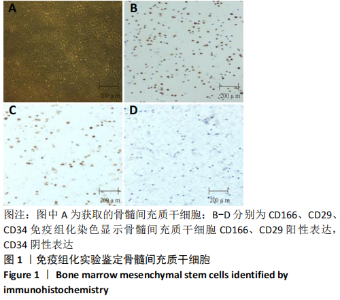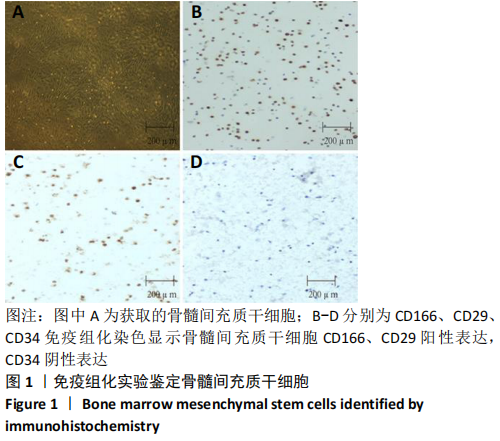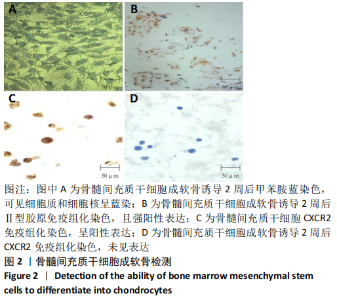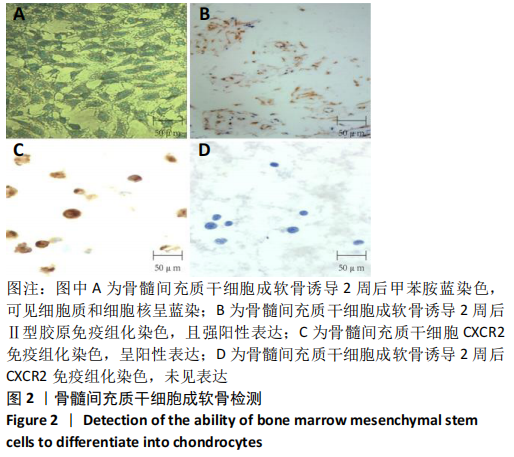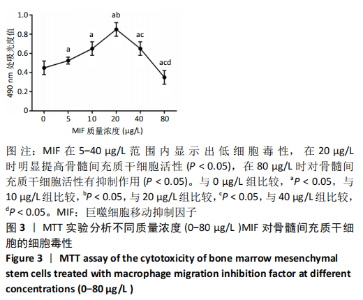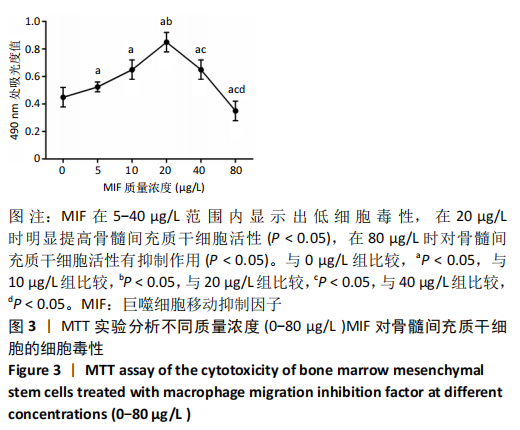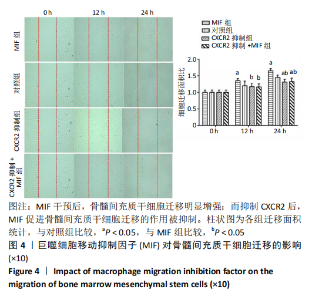Chinese Journal of Tissue Engineering Research ›› 2021, Vol. 25 ›› Issue (25): 4013-4018.doi: 10.12307/2021.013
Previous Articles Next Articles
Macrophage migration inhibition factor promotes bone marrow mesenchymal stem cells homing to repair acute knee cartilage injury
Lu Dinggui, Yao Shunhan, Tang Qianli, Tang Yujin
- Affiliated Hospital of Youjiang Medical College for Nationalities, Baise 533000, Guangxi Zhuang Autonomous Region, China
-
Received:2020-09-02Revised:2020-09-04Accepted:2020-10-16Online:2021-09-08Published:2021-03-27 -
Contact:Tang Yujin, MD, Chief physician, Affiliated Hospital of Youjiang Medical College for Nationalities, Baise 533000, Guangxi Zhuang Autonomous Region, China -
About author:Lu Dinggui, MD, Associate chief physician, Affiliated Hospital of Youjiang Medical College for Nationalities, Baise 533000, Guangxi Zhuang Autonomous Region, China -
Supported by:Basic Ability Improvement Project of Young and Middle-Aged Teachers from Guangxi Colleges and Universities, No. 2018KY0449 (to LDG); Self-Financing Scientific Research Project of Health and Family Planning Commission of Guangxi Zhuang Autonomous Region, No. Z20170243 (to LDG); Scientific Research and Technology Development Plan Project of Baise City, No. 20170512 (to LDG); Guangxi Key Research and Development Project, No. A18050008 (to TYJ)
CLC Number:
Cite this article
Lu Dinggui, Yao Shunhan, Tang Qianli, Tang Yujin. Macrophage migration inhibition factor promotes bone marrow mesenchymal stem cells homing to repair acute knee cartilage injury[J]. Chinese Journal of Tissue Engineering Research, 2021, 25(25): 4013-4018.
share this article
Add to citation manager EndNote|Reference Manager|ProCite|BibTeX|RefWorks
| [1] YANKE AB, LEE AS, KARAS V, et al. Surgeon Ability to Appropriately Address the Calcified Cartilage Layer: An In Vitro Study of Arthroscopic and Open Techniques. Am J Sports Med. 2019;47(11):2584-2588. [2] XU Y, PENG J, RICHARDS G, et al. Optimization of electrospray fabrication of stem cell-embedded alginate-gelatin microspheres and their assembly in 3D-printed poly(ε-caprolactone) scaffold for cartilage tissue engineering. J Orthop Translat. 2019;18:128-141. [3] 王浩,王伟.软骨下钻孔联合软骨源性形态发生蛋白缓释系统修复膝关节软骨缺损[J].中国组织工程研究,2014,18(21):3334-3340. [4] GARCÍA-GARCÍA A, DE CASTILLEJO CL, MÉNDEZ-FERRER S. BMSCs and hematopoiesis. Immunol Lett. 2015;168(2):129-135. [5] RIPA RS, HAACK-SØRENSEN M, WANG Y, et al. Bone marrow derived mesenchymal cell mobilization by granulocyte-colony stimulating factor after acute myocardial infarction: results from the Stem Cells in Myocardial Infarction (STEMMI) trial. Circulation. 2007;116(11 Suppl): I24-I30. [6] LEE RH, PULIN AA, SEO MJ, et al. Intravenous hMSCs improve myocardial infarction in mice because cells embolized in lung are activated to secrete the anti-inflammatory protein TSG-6. Cell Stem Cell. 2009;5(1):54-63. [7] TANG C, JIN C, LI X, et al. Evaluation of an Autologous Bone Mesenchymal Stem Cell-Derived Extracellular Matrix Scaffold in a Rabbit and Minipig Model of Cartilage Repair. Med Sci Monit. 2019;25: 7342-7350. [8] TOH WS, LAI RC, HUI JHP, et al. MSC exosome as a cell-free MSC therapy for cartilage regeneration: Implications for osteoarthritis treatment. Semin Cell Dev Biol. 2017;67:56-64. [9] SOPPERT J, KRAEMER S, BECKERS C, et al. Soluble CD74 Reroutes MIF/CXCR4/AKT-Mediated Survival of Cardiac Myofibroblasts to Necroptosis. J Am Heart Assoc. 2018;7(17):e009384. [10] 邢燕,程东良,史长松.参附注射液抑制HMGB1诱发的CD11b +细胞麻痹对严重脓毒症内皮的保护作用 [J].中华危重病急救医学, 2020,32(6):696-701. [11] 李国梁,潘志坚,柴立新,等.微小RNA-451对巨噬细胞移动抑制因子的调控及对结肠癌细胞增殖与迁移的影响[J].中华实验外科杂志,2019,36(11):2026-2028. [12] BILSBORROW JB, DOHERTY E, TILSTAM PV, et al. Macrophage migration inhibitory factor (MIF) as a therapeutic target for rheumatoid arthritis and systemic lupus erythematosus. Expert Opin Ther Targets. 2019; 23(9):733-744. [13] ZHANG H, YE YL, LI MX, et al. CXCL2/MIF-CXCR2 signaling promotes the recruitment of myeloid-derived suppressor cells and is correlated with prognosis in bladder cancer. Oncogene. 2017;36(15):2095-2104. [14] GALVÃO I, DIAS AC, TAVARES LD, et al. Macrophage migration inhibitory factor drives neutrophil accumulation by facilitating IL-1β production in a murine model of acute gout. J Leukoc Biol. 2016;99(6):1035-1043. [15] KITAYAMA S, ONODERA S, KONDO E, et al. Deficiency of macrophage migration inhibitory factor gene delays healing of the medial collateral ligament: a biomechanical and biological study. J Biomech. 2011;44(3):494-500. [16] 孙延山,卢斌,姜鑫,等.血管内皮细胞生长因子与半月板白区修复中新生血管的长入[J].中国组织工程研究与临床康复,2011, 15(15):2669-2671. [17] FU X, LIU G, HALIM A, et al. Mesenchymal Stem Cell Migration and Tissue Repair. Cells. 2019;8(8):784-791. [18] 李园琦,林海,罗红蓉,等.线粒体自噬与骨髓间充质干细胞成软骨分化的关联[J].中国组织工程研究,2020,24(31):4954-4960. [19] 罗冬章,罗惠娜,詹小舒,等.猫4种不同来源间充质干细胞的生物学特性比较[J].生物技术通报,2019,35(7):39-45. [20] WANG S, HE YF, MA J, et al. Dynamic Bioreactor Culture for Infiltration of Bone Mesenchymal Stem Cells within Electrospun Nanofibrous Scaffolds for Annulus Fibrosus Repair. Orthop Surg. 2020;12(1): 304-311. [21] MILLER EJ, LI J, LENG L, et al. Macrophage migration inhibitory factor stimulates AMP-activated protein kinase in the ischaemic heart. Nature. 2008;451(7178):578-582. [22] CALANDRA T, BUCALA R. Macrophage Migration Inhibitory Factor (MIF): A Glucocorticoid Counter-Regulator within the Immune System. Crit Rev Immunol. 2017;37(2-6):359-370. [23] LEYTON-JAIMES MF, KAHN J, ISRAELSON A. Macrophage migration inhibitory factor: A multifaceted cytokine implicated in multiple neurological diseases. Exp Neurol. 2018;301(Pt B):83-91. [24] GORDON-WEEKS AN, LIM SY, YUZHALIN AE, et al. Macrophage migration inhibitory factor: a key cytokine and therapeutic target in colon cancer. Cytokine Growth Factor Rev. 2015;26(4):451-461. [25] CHANG MC, PARK CR, RHIE SH, et al. Early treadmill exercise increases macrophage migration inhibitory factor expression after cerebral ischemia/reperfusion. Neural Regen Res. 2019;14(7):1230-1236. [26] FUJIHARA Y, HIKITA A, TAKATO T, et al. Roles of macrophage migration inhibitory factor in cartilage tissue engineering. J Cell Physiol. 2018; 233(2):1490-1499. [27] PRESTI M, MAZZON E, BASILE MS, et al. Overexpression of macrophage migration inhibitory factor and functionally-related genes, D-DT, CD74, CD44, CXCR2 and CXCR4, in glioblastoma. Oncol Lett. 2018;16(3): 2881-2886. [28] LIEHN EA, KANZLER I, KONSCHALLA S, et al. Compartmentalized protective and detrimental effects of endogenous macrophage migration-inhibitory factor mediated by CXCR2 in a mouse model of myocardial ischemia/reperfusion. Arterioscler Thromb Vasc Biol. 2013; 33(9):2180-2186. [29] SUBBANNAYYA T, VARIAR P, ADVANI J, et al. An integrated signal transduction network of macrophage migration inhibitory factor. J Cell Commun Signal. 2016;10(2):165-170. [30] ALAMPOUR-RAJABI S, EL BOUNKARI O, ROT A, et al. MIF interacts with CXCR7 to promote receptor internalization, ERK1/2 and ZAP-70 signaling, and lymphocyte chemotaxis. FASEB J. 2015;29(11): 4497-4511. [31] ZHANG Y, ZHU W, HE H, et al. Macrophage migration inhibitory factor rejuvenates aged human mesenchymal stem cells and improves myocardial repair. Aging (Albany NY). 2019;11(24):12641-12660. [32] XIA W, ZHUANG L, HOU M. Role of lincRNA‑p21 in the protective effect of macrophage inhibition factor against hypoxia/serum deprivation‑induced apoptosis in mesenchymal stem cells. Int J Mol Med. 2018;42(4):2175-2184. [33] XIA W, HOU M. Macrophage migration inhibitory factor induces autophagy to resist hypoxia/serum deprivation-induced apoptosis via the AMP-activated protein kinase/mammalian target of rapamycin signaling pathway. Mol Med Rep. 2016;13(3):2619-2626. |
| [1] | Lin Qingfan, Xie Yixin, Chen Wanqing, Ye Zhenzhong, Chen Youfang. Human placenta-derived mesenchymal stem cell conditioned medium can upregulate BeWo cell viability and zonula occludens expression under hypoxia [J]. Chinese Journal of Tissue Engineering Research, 2021, 25(在线): 4970-4975. |
| [2] | Pu Rui, Chen Ziyang, Yuan Lingyan. Characteristics and effects of exosomes from different cell sources in cardioprotection [J]. Chinese Journal of Tissue Engineering Research, 2021, 25(在线): 1-. |
| [3] | Huang Dengcheng, Wang Zhike, Cao Xuewei. Comparison of the short-term efficacy of extracorporeal shock wave therapy for middle-aged and elderly knee osteoarthritis: a meta-analysis [J]. Chinese Journal of Tissue Engineering Research, 2021, 25(9): 1471-1476. |
| [4] | Zhang Xiumei, Zhai Yunkai, Zhao Jie, Zhao Meng. Research hotspots of organoid models in recent 10 years: a search in domestic and foreign databases [J]. Chinese Journal of Tissue Engineering Research, 2021, 25(8): 1249-1255. |
| [5] | Wang Xianyao, Guan Yalin, Liu Zhongshan. Strategies for improving the therapeutic efficacy of mesenchymal stem cells in the treatment of nonhealing wounds [J]. Chinese Journal of Tissue Engineering Research, 2021, 25(7): 1081-1087. |
| [6] | Liao Chengcheng, An Jiaxing, Tan Zhangxue, Wang Qian, Liu Jianguo. Therapeutic target and application prospects of oral squamous cell carcinoma stem cells [J]. Chinese Journal of Tissue Engineering Research, 2021, 25(7): 1096-1103. |
| [7] | Xie Wenjia, Xia Tianjiao, Zhou Qingyun, Liu Yujia, Gu Xiaoping. Role of microglia-mediated neuronal injury in neurodegenerative diseases [J]. Chinese Journal of Tissue Engineering Research, 2021, 25(7): 1109-1115. |
| [8] | Li Shanshan, Guo Xiaoxiao, You Ran, Yang Xiufen, Zhao Lu, Chen Xi, Wang Yanling. Photoreceptor cell replacement therapy for retinal degeneration diseases [J]. Chinese Journal of Tissue Engineering Research, 2021, 25(7): 1116-1121. |
| [9] | Jiao Hui, Zhang Yining, Song Yuqing, Lin Yu, Wang Xiuli. Advances in research and application of breast cancer organoids [J]. Chinese Journal of Tissue Engineering Research, 2021, 25(7): 1122-1128. |
| [10] | Wang Shiqi, Zhang Jinsheng. Effects of Chinese medicine on proliferation, differentiation and aging of bone marrow mesenchymal stem cells regulating ischemia-hypoxia microenvironment [J]. Chinese Journal of Tissue Engineering Research, 2021, 25(7): 1129-1134. |
| [11] | Zeng Yanhua, Hao Yanlei. In vitro culture and purification of Schwann cells: a systematic review [J]. Chinese Journal of Tissue Engineering Research, 2021, 25(7): 1135-1141. |
| [12] | Kong Desheng, He Jingjing, Feng Baofeng, Guo Ruiyun, Asiamah Ernest Amponsah, Lü Fei, Zhang Shuhan, Zhang Xiaolin, Ma Jun, Cui Huixian. Efficacy of mesenchymal stem cells in the spinal cord injury of large animal models: a meta-analysis [J]. Chinese Journal of Tissue Engineering Research, 2021, 25(7): 1142-1148. |
| [13] | Hou Jingying, Yu Menglei, Guo Tianzhu, Long Huibao, Wu Hao. Hypoxia preconditioning promotes bone marrow mesenchymal stem cells survival and vascularization through the activation of HIF-1α/MALAT1/VEGFA pathway [J]. Chinese Journal of Tissue Engineering Research, 2021, 25(7): 985-990. |
| [14] | Shi Yangyang, Qin Yingfei, Wu Fuling, He Xiao, Zhang Xuejing. Pretreatment of placental mesenchymal stem cells to prevent bronchiolitis in mice [J]. Chinese Journal of Tissue Engineering Research, 2021, 25(7): 991-995. |
| [15] | Liang Xueqi, Guo Lijiao, Chen Hejie, Wu Jie, Sun Yaqi, Xing Zhikun, Zou Hailiang, Chen Xueling, Wu Xiangwei. Alveolar echinococcosis protoscolices inhibits the differentiation of bone marrow mesenchymal stem cells into fibroblasts [J]. Chinese Journal of Tissue Engineering Research, 2021, 25(7): 996-1001. |
| Viewed | ||||||
|
Full text |
|
|||||
|
Abstract |
|
|||||
